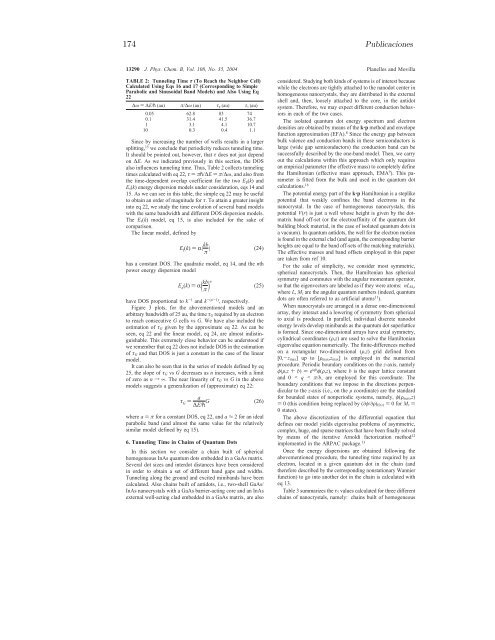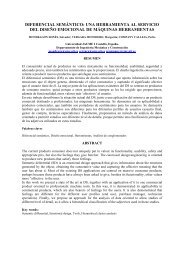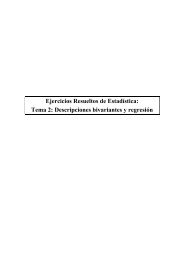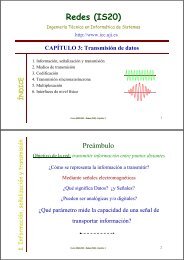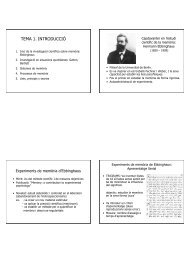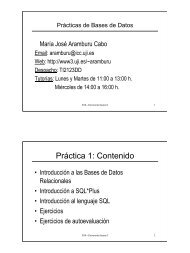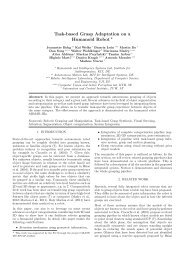174 Publicaciones13290 J. Phys. Chem. B, Vol. 108, No. 35, 2004 Planelles and MovillaTABLE 2: Tunneling Time τ (To Reach the Neighbor Cell)Calculated Using Eqs 16 and 17 (Corresponding to SimpleParabolic and Sinusoidal Band Models) and Also Using Eq22∆ω)∆E/p (au) π/∆ω (au) τ p (au) τ s (au)0.05 62.8 83 740.1 31.4 41.5 36.71 3.1 4.1 10.710 0.3 0.4 1.1Since by increasing the number of wells results in a largersplitting, 15 we conclude that periodicity reduces tunneling time.<strong>It</strong> should be pointed out, however, that τ does not just dependon ∆E. As we indicated previously in this section, the DOSalso influences tunneling time. Thus, Table 2 collects tunnelingtimes calculated with eq 22, τ)πp/∆E)π/∆ω, and also fromthe time-dependent overlap coefficient for the two E p(k) andE s(k) energy dispersion models under consideration, eqs 14 and15. As we can see in this table, the simple eq 22 may be usefulto obtain an order of magnitude for τ. To attain a greater insightinto eq 22, we study the time evolution of several band modelswith the same bandwidth and different DOS dispersion models.The E s(k) model, eq 15, is also included for the sake ofcomparison.The linear model, defined byE l (k))R| kb π | (24)has a constant DOS. The quadratic model, eq 14, and the nthpower energy dispersion modelE n (k))R (kbπ ) n (25)have DOS proportional to k -1 and k -(n-1) , respectively.Figure 3 plots, for the abovementioned models and anarbitrary bandwidth of 25 au, the time τ G required by an electronto reach consecutive G cells vs G. We have also included theestimation of τ G given by the approximate eq 22. As can beseen, eq 22 and the linear model, eq 24, are almost indistinguishable.This extremely close behavior can be understood ifwe remember that eq 22 does not include DOS in the estimationof τ G and that DOS is just a constant in the case of the linearmodel.<strong>It</strong> can also be seen that in the series of models defined by eq25, the slope of τ G vs G decreases as n increases, with a limitof zero as nf∞. The near linearity of τ G vs G in the abovemodels suggests a generalization of (approximate) eq 22:τ G ) a∆E/p G (26)where a ) π for a constant DOS, eq 22, and a ≈ 2 for an idealparabolic band (and almost the same value for the relativelysimilar model defined by eq 15).6. Tunneling Time in Chains of Quantum DotsIn this section we consider a chain built of sphericalhomogeneous InAs quantum dots embedded in a GaAs matrix.Several dot sizes and interdot distances have been consideredin order to obtain a set of different band gaps and widths.Tunneling along the ground and excited minibands have beencalculated. Also chains built of antidots, i.e., two-shell GaAs/InAs nanocrystals with a GaAs barrier-acting core and an InAsexternal well-acting clad embedded in a GaAs matrix, are alsoconsidered. Studying both kinds of systems is of interest becausewhile the electrons are tightly attached to the nanodot center inhomogeneous nanocrystals, they are distributed in the externalshell and, then, loosely attached to the core, in the antidotsystem. Therefore, we may expect different conduction behaviorsin each of the two cases.The isolated quantum dot energy spectrum and electrondensities are obtained by means of the k‚p method and envelopefunction approximation (EFA). 8 Since the energy gap betweenbulk valence and conduction bands in these semiconductors islarge (wide gap semiconductors) the conduction band can besuccessfully described by the one-band model. Then, we carryout the calculations within this approach which only requiresan empirical parameter (the effective mass) to completely definethe Hamiltonian (effective mass approach, EMA 9 ). This parameteris fitted from the bulk and used in the quantum dotcalculations. 16The potential energy part of the k‚p Hamiltonian is a steplikepotential that weakly confines the band electrons in thenanocrystal. In the case of homogeneous nanocrystals, thispotential V(r) is just a well whose height is given by the dotmatrixband off-set (or the electroaffinity of the quantum dotbuilding block material, in the case of isolated quantum dots ina vacuum). In quantum antidots, the well for the electron motionis found in the external clad (and again, the corresponding barrierheights are equal to the band off-sets of the matching materials).The effective masses and band offsets employed in this paperare taken from ref 10.For the sake of simplicity, we consider most symmetric,spherical nanocrystals. Then, the Hamiltonian has sphericalsymmetry and commutes with the angular momentum operator,so that the eigenvectors are labeled as if they were atoms: nL Mz ,where L, M z are the angular quantum numbers (indeed, quantumdots are often referred to as artificial atoms 11 ).When nanocrystals are arranged in a dense one-dimensionalarray, they interact and a lowering of symmetry from sphericalto axial is produced. In parallel, individual discrete nanodotenergy levels develop minibands as the quantum dot superlatticeis formed. Since one-dimensional arrays have axial symmetry,cylindrical coordinates (F,z) are used to solve the Hamiltonianeigenvalue equation numerically. The finite-differences methodon a rectangular two-dimensional (F,z) grid defined from[0,-z max] up to [F max,z max] is employed in the numericalprocedure. Periodic boundary conditions on the z-axis, namelyφ(F,z + b) ) e iqb φ(F,z), where b is the super lattice constantand 0 < q < π/b, are employed for this coordinate. Theboundary conditions that we impose in the directions perpendicularto the z-axis (i.e., on the F coordinate) are the standardfor bounded states of nonperiodic systems, namely, φ(F max,z)) 0 (this condition being replaced by (∂φ/∂F) (0,z) ) 0 for M z )0 states).The above discretization of the differential equation thatdefines our model yields eigenvalue problems of asymmetric,complex, huge, and sparse matrices that have been finally solvedby means of the iterative Arnoldi factorization method 12implemented in the ARPAC package. 13Once the energy dispersions are obtained following theabovementioned procedure, the tunneling time required by anelectron, located in a given quantum dot in the chain (andtherefore described by the corresponding nonstationary Wannierfunction) to go into another dot in the chain is calculated witheq 13.Table 3 summarizes the τ 5 values calculated for three differentchains of nanocrystals, namely: chains built of homogeneous
Confinamiento periódico 175Tunneling in Chains of Quantum Dots J. Phys. Chem. B, Vol. 108, No. 35, 2004 13291TABLE 3: Tunneling Time τ 5 Calculated for DifferentNanocrystal Chains ad)0.0 nm d)1.5 nm d)3.0 nm∆E (meV) τ 5 (au) ∆E (meV) τ 5 (au) ∆E (meV)τ 5 (au)B 1 17.39 20 024 5.36 65 097 1.74 20 0738HL B 2 84.36 4194 30.07 11 620 11.01 31 710B 3 136.78 2556 61.05 5694 26.60 13 112B 1 34.63 10 035 11.23 31 079 3.78 92 450HS B 2 155.83 2298 61.52 5690 24.73 14 122B 3 186.81 1777 101.22 3343 54.39 6351B 1 6.15 56 695 21.15 16 090 15.47 22 158A B 2 32.69 10 745 68.67 5908 41.48 8997B 3 59.97 6051 103.82 4010 56.84 6475aNamely, a chain built of 8 nm radius homogeneous InAs QDs (HL),a chain built of 6.5 nm radius homogeneous InAs QDs (HS), and chainsbuilt of two-shell GaAs/InAs antidots, 8 nm core and 2 nm shell (A),for three interdot distances (d ) 0 represents touching dots) and threelowest M z ) 0 minibands (B1 being the ground miniband).InAs QDs with a radius of 8 nm (HL), chains built ofhomogeneous InAs QDs with a radius of 6.5 nm (HS), andchains built of GaAs/InAs antidots with an 8 nm radius GaAscore capped bya2nmInAs shell (A). Three interdot distances,d ) 0 (touching dots), d ) 1.5 nm, and d ) 3 nm, and threelowest B1, B2, and B3 M z)0minibands have been considered.For the sake of completeness, bandwidths are also enclosed inTable 3.We can see from Table 3 that the chain built of smallhomogeneous nanocrystals (HS) shows lower τ 5 values (andthus, higher electron mobilities) than the chain built of largehomogeneous nanocrystals (HL). We can also see that for chainsbuilt of homogeneous QDs, the higher the nanocrystal densityis, the lower the τ 5 tunneling times and the higher the electronmobilities will be. This is not the case of the chain built ofantidots (A) whose electron mobility rises as the QDs get closer,reaches a maximum for a given value of interdot distance d(which is quite similar but not exactly the same for the differentminibands under study) and finally decreases as they get closeruntil they touch each other. This behavior is related to the factthat the minibands cross for a given density and the structurereveals a semimetallic character. However, when the nanocrystalsoverlap by more than a given threshold, the minibandsstart to overlap, and then, new minigaps open at the crossingpoints and the structure loses the attained semimetallic character.In general, the electron mobility in the ground 1B minibandis smaller than in the excited 2B, 3B minibands, the bandwitdthbecomes narrower, and the calculated miniband dispersion isnearly parabolic with zero derivatives at the band edges (so thatalmost all calculated τ 5 values may be approximated by eq 26with a ≈ 2.14). However, DOS also plays a role. We can seein Table 3 that the 3B bandwidth of a chain having an interdotdistance d ) 1.5 nm and built of small QDs (HS) is similar tothe one with the same characteristics but built of antidots (A)(10.122 and 10.383 eV, respectively). Hence, one may expectthat the antidot-chain tunneling time τ 5(A) will be just a littlesmaller than τ 5(HS), since the antidot bandwidth is a bit wider.However, we can see from Table 3 that τ 5(A) ) 4010 au isquite a lot larger than τ 5(HS) ) 3343 au. By looking at theenergy dispersion of the bands involved we can understand thisflipping as coming from a different DOS in each of the twocases: while HS-dispersion is almost parabolic (τ 5(HS) fits eq26 if a ≈ 2.03), A-dispersion is nearly linear (τ 5(A) fits eq 26if a ≈ 2.93, which is a value close to π, corresponding to anideal linear dispersion).7. Concluding RemarksIn this paper, we have introduced the concept of timedependentoverlap between Wannier functions. <strong>It</strong> allows thetunneling time along 1D quantum dot superlattices to becalculated quickly and easy. A comparison of the electronmobility in 1D arrays of homogeneous and two-shell antidotnanocrystals has been also carried out. <strong>It</strong> is found that while amonotonic increase in electron mobility vs nanocrystal densitytakes place in chains of homogeneous nanocrystals, quitedifferent behavior occurs in chains of antidots. First it growsas the QDs get closer, reaches a maximum for a given value ofinterdot distance d, and then decreases as the QDs get closeruntil they touch each other.The proposed time-dependent overlap coefficient and theresults obtained can be useful in the study and design of newelectronic devices.Acknowledgment. Financial support from UJI-Bancaixa P1-B2002-01 is gratefully acknowledged. The Spanish MECD FPUgrant (J.L.M.) is also acknowledged.References and Notes(1) (a) Flebbe, O.; Eisele, H.; Kalka, T.; Heinrichsdorff, F.; Krost, A.;Bimberg, D.; Dähne-Prietsch, M. J. Vac. Sci. Technol. B 1999, 17, 1639.(b) Heitz, R.; Kalburge, A.; Xie, Q.; Grundmann, M.; Chen, P.; Holffmann,A.; Madhukar, A. Phys. ReV. B1998, 57, 9050. (c) Lee, S. C.; Dawson, R.L.; Malloy, K. J.; Brueck, S. R. J. Appl. Phys. Lett. 2001, 79, 2630.(2) (a) Dıaz, J. G.; Jaskólski, W.; Planelles, J.; Aizpurua, J.; Bryant,G. W. J. Chem. Phys. 2003, 119, 7484. (b) Dıaz, J. G.; Planelles, J. J.Phys. Chem. B 2004, 108, 2873.(3) Kouwenhoven, L. P.; Hekking, F. W. J.; van Wees, B. J.; Harmans,C. J. P. M.; Timmering C. E.; Foxon, C. T. Phys. ReV. Lett. 1990, 65, 361.(4) Brum, J. A. Phys. ReV. B1991, 43, 12082.(5) Wacker, A. Phys. Rep. 2002, 357, 1.(6) Kohn, W. Phys. ReV. 1959, 115, 809.(7) Marzari, N.; Vanderbilt, D. Phys. ReV. B1997, 56, 12847.(8) (a) Sercel, P. C.; Vahala, K. J. Phys. ReV. B1990, 42, 3690. (b)Efros, Al. L.; Rosen, M. Phys. ReV. B1998, 58, 7120.(9) Bastard, G. WaVe Mechanics Applied to Semiconductor Heteroestructures;Les EÄ ditions de Physique: Les Ulis, France, 1988.(10) Cao, Y. W.; Banin, U. Am. J. Chem. Soc. 2000, 122, 9692.(11) Cheng, S. J.; Sheng, W. D.; Hawrylak, P. Phys. ReV. B2003, 68,235330.(12) (a) Arnoldi, W. E. Q. J. Appl. Math. 1951, 9, 17. (b) Saad, Y.Numerical Methods for large Scale EigenValue Problems; Halsted Press:New York, 1992. (c) Morgan, R. B. Math. Comput. 1996, 65, 1213.(13) (a) Lehoucq, R. B.; Sorensen, D. C.; Vu, P. A.; Yang, C.ARPACK: Fortran subroutines for solVing large scale eigenValue problems,Release 2.1; SIAM: Philadelphia, PA, 1998. (b) Lehoucq, R. B.; Sorensen,D. C.; Yang, C. ARPACK User’s Guide: Solution of Large-Scale EigenValueProblems with Implicit Restarted Arnoldi Methods; SIAM: Philadelphia,PA, 1998.(14) We write sin (kb/2) instead of the more common cos kb becauseour cell is defined in [-b/2,b/2] instead of [0,b].(15) <strong>It</strong> goes from ∆E)2β in ethylene up to ∆E)4β in polyacetylene,β being the empirical resonance integral.(16) In the present calculations, we have not included nonparabolicityeffects on the effective mass.
- Page 1:
CONFINAMIENTO NANOSCÓPICO ENESTRUC
- Page 5 and 6:
AgradecimientosDecía Albert Einste
- Page 7:
A mi madreA la memoria de mi padre
- Page 10 and 11:
viiihigh-correlation electronic reg
- Page 12 and 13:
xric) resolution method proves the
- Page 14 and 15:
xii14. F. Rajadell, J.L. Movilla, M
- Page 16 and 17:
xivcen para moldear a voluntad su e
- Page 18 and 19:
xvideterminar las características
- Page 23 and 24:
Capítulo 1Fundamentos teóricosEl
- Page 25 and 26:
1.1 Modelo k · p 3donde p = −i¯
- Page 27 and 28:
1.1 Modelo k · p 5inversa de la ma
- Page 29 and 30:
1.2 Heteroestructuras. Aproximació
- Page 31 and 32:
1.3 Masa efectiva dependiente de la
- Page 33 and 34:
1.4 Aplicación de un campo magnét
- Page 35 and 36:
1.5 Potenciales monopartícula adic
- Page 37 and 38:
1.6 Integración numérica del hami
- Page 39 and 40:
1.7 Transiciones intrabanda 17Tras
- Page 41 and 42:
1.7 Transiciones intrabanda 19g) [7
- Page 43 and 44:
Capítulo 2Confinamientos espacial
- Page 45 and 46:
23esta aproximación asume implíci
- Page 47 and 48:
2.1 Puntos cuánticos de InAs en ma
- Page 49 and 50:
2.1 Puntos cuánticos de InAs en ma
- Page 51 and 52:
2.1 Puntos cuánticos de InAs en ma
- Page 53 and 54:
2.1 Puntos cuánticos de InAs en ma
- Page 55 and 56:
Capítulo 3Confinamiento periódico
- Page 57 and 58:
3.1 Funciones de Wannier 35otro con
- Page 59 and 60:
3.1 Funciones de Wannier 373.1.1. F
- Page 61 and 62:
3.2 Evolución temporal en modelos
- Page 63 and 64:
3.2 Evolución temporal en modelos
- Page 65 and 66:
3.2 Evolución temporal en modelos
- Page 67 and 68:
3.3 Tiempo de tunneling en cadenas
- Page 69 and 70:
3.3 Tiempo de tunneling en cadenas
- Page 71 and 72:
Capítulo 4Confinamiento magnético
- Page 73 and 74:
51donde m ∗ es la masa efectiva d
- Page 75 and 76:
4.1 Magnetización de puntos y anil
- Page 77 and 78:
4.1 Magnetización de puntos y anil
- Page 79 and 80:
4.1 Magnetización de puntos y anil
- Page 81 and 82:
4.2 Acoplamiento lateral de anillos
- Page 83 and 84:
4.2 Acoplamiento lateral de anillos
- Page 85 and 86:
4.2 Acoplamiento lateral de anillos
- Page 87 and 88:
4.2 Acoplamiento lateral de anillos
- Page 89 and 90:
Capítulo 5Confinamiento dieléctri
- Page 91 and 92:
69Más complicado pero también ana
- Page 93 and 94:
5.1 Validez de la electrodinámica
- Page 95 and 96:
5.2 Interacciones culómbicas en pu
- Page 97 and 98:
5.2 Interacciones culómbicas en pu
- Page 99 and 100:
5.3 Barreras confinantes finitas e
- Page 101 and 102:
5.3 Barreras confinantes finitas e
- Page 103 and 104:
5.3 Barreras confinantes finitas e
- Page 105 and 106:
5.3 Barreras confinantes finitas e
- Page 107 and 108:
5.4 Impurezas dadoras hidrogenoides
- Page 109 and 110:
5.4 Impurezas dadoras hidrogenoides
- Page 111 and 112:
5.4 Impurezas dadoras hidrogenoides
- Page 113 and 114:
5.4 Impurezas dadoras hidrogenoides
- Page 115 and 116:
5.4 Impurezas dadoras hidrogenoides
- Page 117 and 118:
5.4 Impurezas dadoras hidrogenoides
- Page 119 and 120:
5.4 Impurezas dadoras hidrogenoides
- Page 121 and 122:
5.4 Impurezas dadoras hidrogenoides
- Page 123 and 124:
5.4 Impurezas dadoras hidrogenoides
- Page 125 and 126:
5.4 Impurezas dadoras hidrogenoides
- Page 127 and 128:
5.4 Impurezas dadoras hidrogenoides
- Page 129 and 130:
5.5 Estados superficiales inducidos
- Page 131 and 132:
5.5 Estados superficiales inducidos
- Page 133 and 134:
5.5 Estados superficiales inducidos
- Page 135 and 136:
5.5 Estados superficiales inducidos
- Page 137 and 138:
5.5 Estados superficiales inducidos
- Page 139 and 140:
5.5 Estados superficiales inducidos
- Page 141 and 142:
5.5 Estados superficiales inducidos
- Page 143 and 144:
5.5 Estados superficiales inducidos
- Page 145 and 146: 5.5 Estados superficiales inducidos
- Page 147 and 148: 5.5 Estados superficiales inducidos
- Page 149 and 150: 5.5 Estados superficiales inducidos
- Page 151 and 152: 5.5 Estados superficiales inducidos
- Page 153 and 154: 5.5 Estados superficiales inducidos
- Page 155 and 156: 5.5 Estados superficiales inducidos
- Page 157 and 158: 5.5 Estados superficiales inducidos
- Page 159 and 160: 5.5 Estados superficiales inducidos
- Page 161 and 162: 5.5 Estados superficiales inducidos
- Page 163 and 164: 5.5 Estados superficiales inducidos
- Page 165 and 166: 5.5 Estados superficiales inducidos
- Page 167 and 168: 5.5 Estados superficiales inducidos
- Page 169 and 170: 5.5 Estados superficiales inducidos
- Page 171 and 172: 5.5 Estados superficiales inducidos
- Page 173 and 174: 5.5 Estados superficiales inducidos
- Page 175 and 176: Capítulo 6ConclusionesEn esta Tesi
- Page 177 and 178: 155entre los anillos como la orient
- Page 179 and 180: 157fuerte decaimiento de la intensi
- Page 181 and 182: Publicaciones
- Page 183 and 184: Confinamientos espacial y másico
- Page 185 and 186: Confinamientos espacial y másico 1
- Page 187 and 188: Confinamientos espacial y másico 1
- Page 189 and 190: Confinamientos espacial y másico 1
- Page 191 and 192: Confinamiento periódico
- Page 193 and 194: Confinamiento periódico 171J. Phys
- Page 195: Confinamiento periódico 173Tunneli
- Page 199 and 200: Confinamiento magnético
- Page 201 and 202: Confinamiento magnético 179Symmetr
- Page 203 and 204: Confinamiento magnético 181Aharono
- Page 205 and 206: Confinamiento magnético 183Aharono
- Page 207 and 208: Confinamiento magnético 185Aharono
- Page 209 and 210: Confinamiento magnético 187PHYSICA
- Page 211 and 212: Confinamiento magnético 189MAGNETI
- Page 213 and 214: Confinamiento magnético 191IOP Pub
- Page 215 and 216: Confinamiento magnético 193938Mean
- Page 217 and 218: Confinamiento magnético 195940QRs
- Page 219 and 220: Confinamiento dieléctrico
- Page 221 and 222: Confinamiento dieléctrico 199Compu
- Page 223 and 224: Confinamiento dieléctrico 201146 J
- Page 225 and 226: Confinamiento dieléctrico 203148 J
- Page 227 and 228: Confinamiento dieléctrico 205150 J
- Page 229 and 230: Confinamiento dieléctrico 207152 J
- Page 231 and 232: Confinamiento dieléctrico 209PHYSI
- Page 233 and 234: Confinamiento dieléctrico 211OFF-C
- Page 235 and 236: Confinamiento dieléctrico 213OFF-C
- Page 237 and 238: Confinamiento dieléctrico 215OFF-C
- Page 239 and 240: Confinamiento dieléctrico 217PHYSI
- Page 241 and 242: Confinamiento dieléctrico 219BRIEF
- Page 243 and 244: Confinamiento dieléctrico 221PHYSI
- Page 245 and 246: Confinamiento dieléctrico 223TRAPP
- Page 247 and 248:
Confinamiento dieléctrico 225Deloc
- Page 249 and 250:
Confinamiento dieléctrico 227V s (
- Page 251 and 252:
Confinamiento dieléctrico 229with
- Page 253 and 254:
Confinamiento dieléctrico 231value
- Page 255 and 256:
Confinamiento dieléctrico 233(R in
- Page 257 and 258:
Confinamiento dieléctrico 23525R i
- Page 259 and 260:
Confinamiento dieléctrico 237monoe
- Page 261 and 262:
Confinamiento dieléctrico 239[8] Y
- Page 263 and 264:
Confinamiento dieléctrico 241[48]
- Page 265 and 266:
Confinamiento dieléctrico 243PHYSI
- Page 267 and 268:
Confinamiento dieléctrico 245FROM
- Page 269 and 270:
Confinamiento dieléctrico 247PHYSI
- Page 271 and 272:
Confinamiento dieléctrico 249THEOR
- Page 273 and 274:
Confinamiento dieléctrico 251THEOR
- Page 275 and 276:
Confinamiento dieléctrico 253PHYSI
- Page 277 and 278:
Confinamiento dieléctrico 255DIELE
- Page 279 and 280:
Confinamiento dieléctrico 257DIELE
- Page 281 and 282:
Confinamiento dieléctrico 259DIELE
- Page 283 and 284:
Confinamiento dieléctrico 261DIELE
- Page 285 and 286:
Confinamiento dieléctrico 263PHYSI
- Page 287 and 288:
Confinamiento dieléctrico 265FAR-I
- Page 289 and 290:
Confinamiento dieléctrico 267FAR-I
- Page 291 and 292:
Confinamiento dieléctrico 269Diele
- Page 293 and 294:
Confinamiento dieléctrico 271Diele
- Page 295 and 296:
Confinamiento dieléctrico 273Diele
- Page 297 and 298:
Confinamiento dieléctrico 275Diele
- Page 299 and 300:
Confinamiento dieléctrico 277Diele
- Page 301 and 302:
Confinamiento dieléctrico 279Diele
- Page 303 and 304:
Confinamiento dieléctrico 281Diele
- Page 305 and 306:
Confinamiento dieléctrico 283Diele
- Page 307 and 308:
Confinamiento dieléctrico 285Diele
- Page 309 and 310:
Confinamiento dieléctrico 287Diele
- Page 311 and 312:
Confinamiento dieléctrico 289Diele
- Page 313 and 314:
Confinamiento dieléctrico 291Diele
- Page 315 and 316:
Bibliografía[1] J. Karwowski,“In
- Page 317 and 318:
BIBLIOGRAFÍA 295[23] J.L. Movilla,
- Page 319 and 320:
BIBLIOGRAFÍA 297[48] M.G. Burt,
- Page 321 and 322:
BIBLIOGRAFÍA 299[71] W.H. Press, S
- Page 323 and 324:
BIBLIOGRAFÍA 301[97] U.H. Lee, D.
- Page 325 and 326:
BIBLIOGRAFÍA 303[121] S.W. Chung,
- Page 327 and 328:
BIBLIOGRAFÍA 305[145] R. Blossey y
- Page 329 and 330:
BIBLIOGRAFÍA 307[169] F. Suárez,
- Page 331 and 332:
BIBLIOGRAFÍA 309[194] C. Delerue,
- Page 333 and 334:
BIBLIOGRAFÍA 311[220] J.L. Zhu y X
- Page 335 and 336:
BIBLIOGRAFÍA 313[245] L.M. Peter,
- Page 337 and 338:
BIBLIOGRAFÍA 315[266] P. Rinke, K.
- Page 339 and 340:
BIBLIOGRAFÍA 317[289] Y. Wang, L.
- Page 341 and 342:
BIBLIOGRAFÍA 319[314] A. Wójs y P


